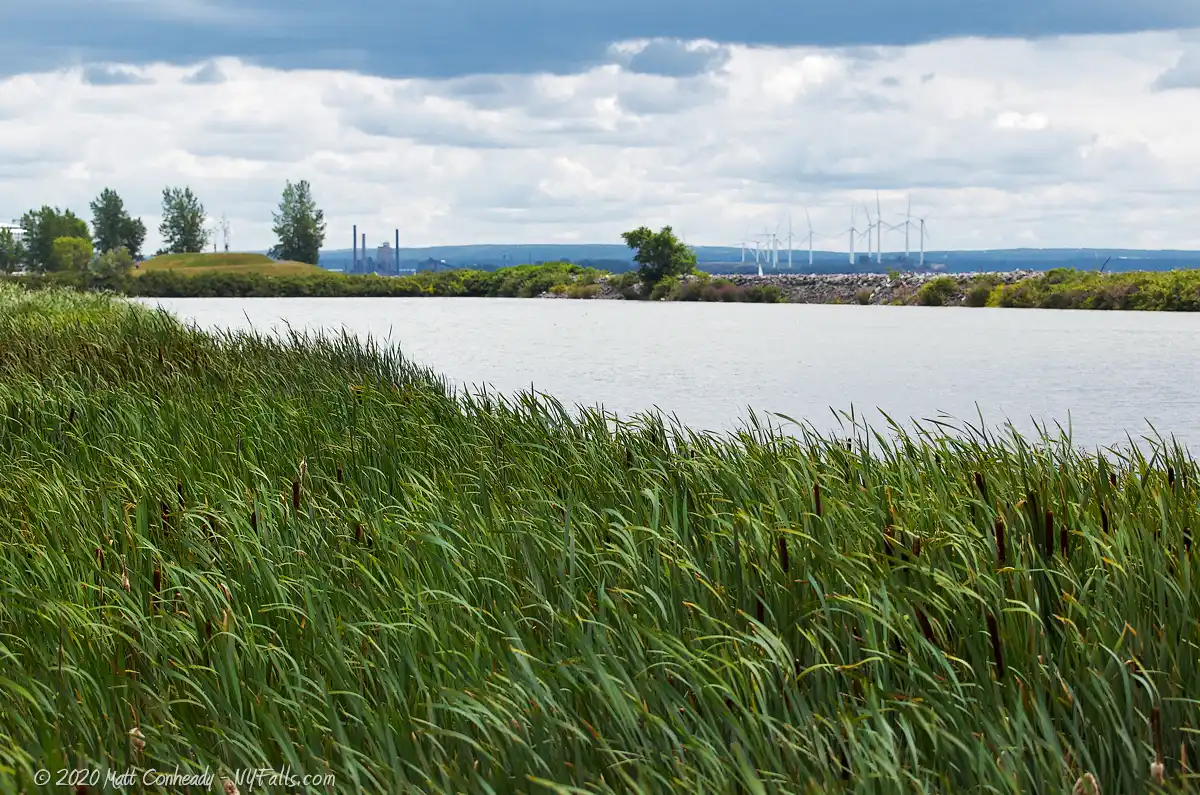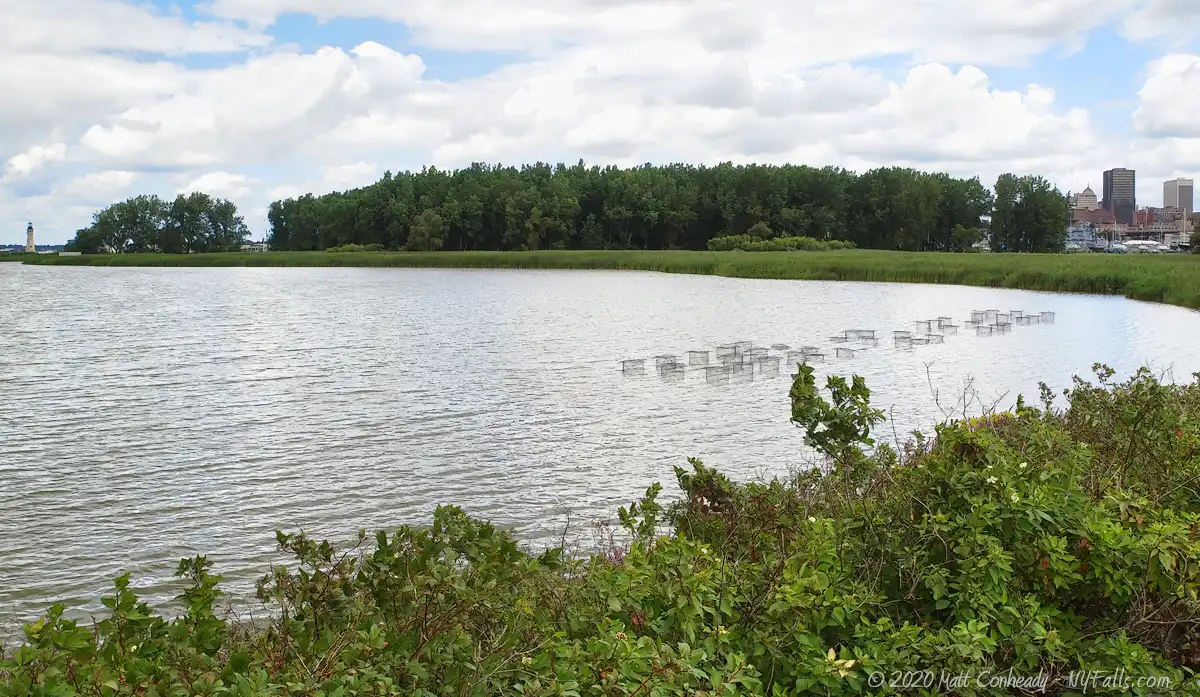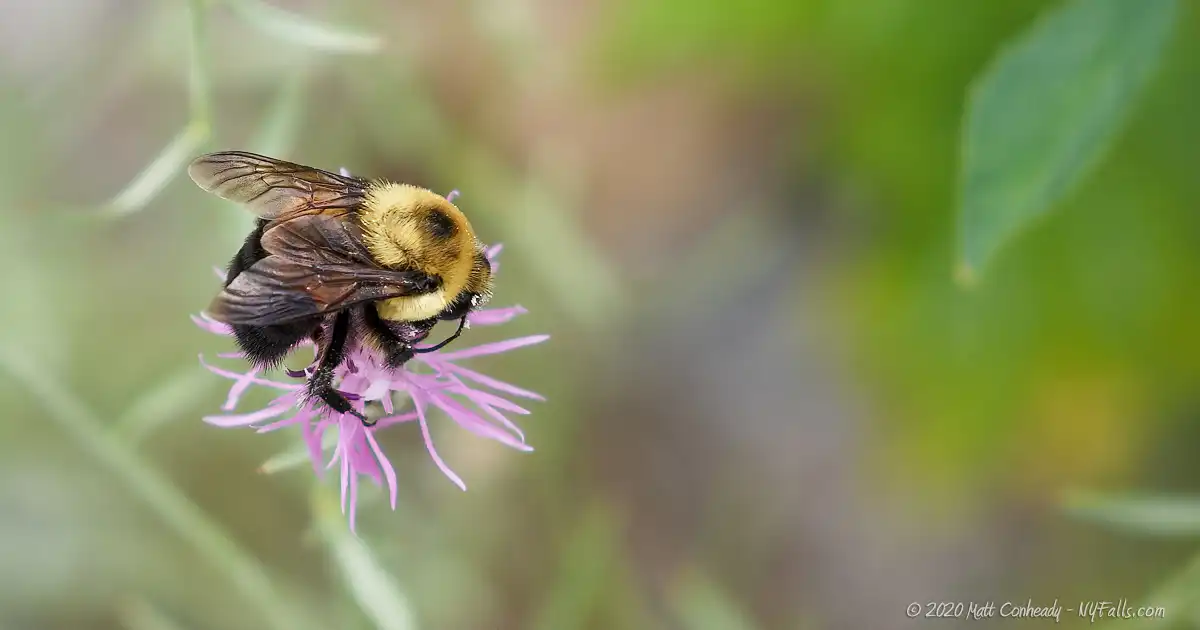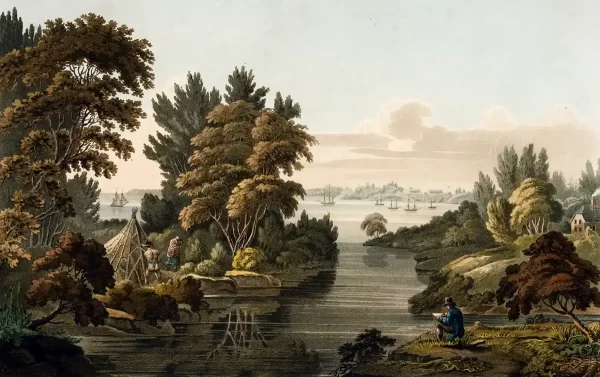
Note: Due to storm surges in October of 2019, that resulted in permanent damage to the boardwalk and other facilities at the preserve, some of the trails are not accessible as of 2023.
Location: On the northeast end of Lake Erie; within the Buffalo Outer Harbor; City of Buffalo; Erie County; New York.
Maps: Google map; Topographic; Interactive map
GPS Coordinates:
- Roadside Parking: N 42.87431 / W 78.88242
- Main Entrance: N 42.87429 / W 78.88255
- North Trail bird-blind: N 42.87569 / W 78.88755
Directions: From Buffalo (north): Take the Buffalo Skyway (NY-5) south to Outer Harbor Drive/Fuhrmann Blvd. Take Fuhrmann Blvd North about a half a mile. Look for the preserve on your left.
From Erie/Dunkirk (south): You can follow NY-5 (Lakeshore Rd.) north into Buffalo and right to the Outer Harbor.
Use Google Maps.
Parking: Roadside parking is available up and down Fuhrman Blvd. If roadside lots are full, try Wilkeson Pointe Park. Do not block the Coast Guard Base entrance at the north end of Fuhrmann.
Weather
Information / Accessibility / Accommodations
Seasons/Hours: Open year-round. Day and night.
Admission: Free.
Best time to visit: For the spring and fall bird migrations.
Time: A walk around the preserve will take about 30 minutes. Stop to watch birds on a busy migration day and this can easily take several hours. Combine this with Lighthouse Point Park, Wilkeson Pointe Park, and the Outer Harbor Greenway for an easy half day.
Handicap accessibility: No.
Pets: Not allowed at all. Do not bring your dog into this property.
Swimming: Not allowed.
Boat launch: None. Use the boat launch at the Erie Basin Marina.
Accommodations: Informational signs, bird watching blinds, trails. Restrooms can be found to the south in Wilkeson Pointe Park.


Description
Times Beach, in the City of Buffalo, eastern end of the Rust Belt, and along the highly developed Lake Erie Shoreline, is one of New York’s best reclamation cases. This 55 acre swatch of land, formerly a dumping ground for dredging waste from one of the most polluted waterways of the Great Lakes Region, is now an important fish and wildlife habitat in a region in desperate need of them. What makes Times Beach such an interesting case is that in the grand scheme, it’s fairly new. It did not exist prior to 1867 when a seawall was constructed to protect the Buffalo River harbor, and sand began piling up against the seawall. And it wasn’t until the 1970s that a wetland habitat took hold here. Being new, the land and water of this nearly-enclosed area is in a state of transition, creating a fragile array of habitats serving a variety of creatures. From the immature woodland of the northeast quarter, down the sloping beach to grassland and brush, past emerging wetlands covered in reeds, to the mud flats and deeper water, there’s a home and food for vast numbers of insects, fish, birds, and mammals here.
Diversity is immediately apparent when one visits. Within minutes of our first visit, we spotted nearly a dozen species of small birds, several ducks, too many butterflies to count, and a group of whitetail deer, who didn’t seem to mind visitors walking just a few feet by their morning meal. Being an important stopover for migrating waterfowl and birds of prey, Times Beach and its three large public birding blinds, right on the fringe of the marsh, are an excellent place to view the spring and fall migrations. The preserve also has a fine set of trails and boardwalks that make navigating the property a breeze. Colorful signs throughout the trails explain the history, importance, highlight common bird species to look out for, and even address the issue of invasive species that threaten the health of the preserve. The preserve is easy to visit, with plenty of parking, and sits along the Outer Harbor Trail, which passes by a few other parks nearby, helping to build up the Outer Harbor as a wonderful break from adjacent downtown Buffalo. If you are in the area, and appreciate nature, or just need to get away from traffic and noise, this is a highly recommended stop. Bring binoculars.
On October 31, 2019, a seiche event on Lake Erie caused a dramatic seven-foot rise in water levels along the Buffalo Metro shoreline, severely impacting Times Beach Nature Preserve. The Preserve suffered extensive damage to its boardwalk and trail system, along with over 3,000 cubic yards of debris accumulation, prompting a Disaster Declaration by FEMA in December 2019. Subsequent weather events in 2021 and 2022 inflicted further harm. Consequently, approximately half of the trails at Times Beach Nature Preserve were closed to the public. In a positive turn, volunteer efforts in spring 2023 have successfully reopened trails on the western end of the Preserve, including an overlook and a bird blind, although visitors are advised to proceed with caution and enjoy the area responsibly.


History
The first inhabitants of the eastern Erie shoreline were Native Americans, with the Seneca tribe of the Iroquois Confederacy controlling this “western door” of their territory. In 1797 the Holland Land Company purchased much of Western New York from the Seneca, and that block of land was divided and resold, with plans for the Village of Buffalo as a port city beginning as early as 1801. An 1805 act of Congress created the port at Buffalo, which initiated a long history of development along the Erie and Niagara shoreline. Little of what exists today is an original feature of the lake, but one thing we do know, is that much of this shoreline was originally a wetland and a critical stopover for migratory birds as they journey across the Great Lakes.
Buffalo’s Outer Harbor changed drastically as improvements to the Inner Harbor were made as the Erie Canal became the centerpiece of eastward shipping. The Buffalo River often filled with sediments making navigation in and out of it difficult. The river outlet was dredged and the south seawall was built in 1867. It prevented sand and mud from building up in the river, and instead it built up along the seawall, creating a beach. This new strip of land became a shanty-town known as “Seawall Beach”, inhabited by Irish and other immigrant port workers and their families. Records show it was a rowdy and nearly lawless neighborhood, with harsh living conditions and high death rates due to storm surges. The city was eager to get rid of it. With the Outer Harbor developing along with Buffalo’s growing shipping and grain industries, the shanty-town was dismantled and the space utilized for industry. A rail line was built along the sandbar in the 1920s to service grain elevators and docked ships along the seawall.
As Buffalo’s shipping industry began to wane during the Great Depression, industry and traffic along the Outer Harbor diminished and much of it went unused. In 1931, the Buffalo Times newspaper proposed using the swatch of land as a free municipal bathing beach, and later that year it was opened as “Times Beach” in honor of the paper’s idea. Swimming took place at Times Beach until the 1940s when it was deemed hazardous to public health due to industrial pollution in Lake Erie and the Buffalo Harbor.
The property sat unused until 1971 when the Army Corps of Engineers began using it to dump soil dredged from the Inner Harbor, Buffalo River, and Black Rock Canal. Dikes were built to surround the beach and contain the dredging waste. Over the next 5 years, over 550,000 cubic yards of sediment was dumped here. Around this time, people began to notice a variety of plant, fish, and bird-life that took up residence along the beach, and the formation of new wetland along this man-made property despite the contamination. The dumping stopped in 1976, when it was found that the dredged materials were highly contaminated, and the newly established wetland habitats may be compromised by any further dumping. In 1987, the New York Department of State recognized it as a significant coastal fish and wildlife habitat.
It is now owned by the City of Buffalo, and operated as a nature preserve by the city and Erie County, with help from the Friends of Times Beach Nature Preserve.

Hiking / Walking Trails
Note: As of 2023, some of the trails have not been restored from water damage. This is mostly on the eastern end, while volunteers have done a wonderful job restoring trails on the west side.
Difficulty: Easy
Distance: about 3500 ft if you walk all branches of the trail.
Markings: Signs at every entrance. Stone pathways and wood boardwalks. Informational signs throughout the trail.
Description: The preserve features maps at every entrance. Our recommendation is to start at the northernmost entrance and to stick right, heading to the north end of the park and the birding blind at the end of the trail.
From there, backtrack and stick right along the boardwalk. At the bend will be an offshoot to another birding blind. Head back and stick right. This will lead back to the north entrance. Continue right down the trail parallel to Fuhrmann Blvd. You will pass the middle entrance, then an offshoot to the left, which will be the south entrance. Head right. Soon you will pass an overlook of the wetlands. Continue on to reach the south birding blind.
Although it is not a part of the trail, you can head out along the breakwater at the south end to just where it bends across. Be careful, the stones are uneven and loose.
Map: Click here






